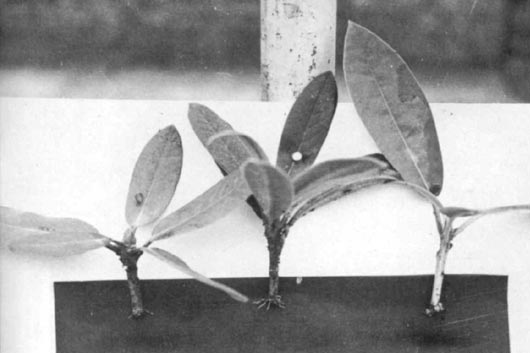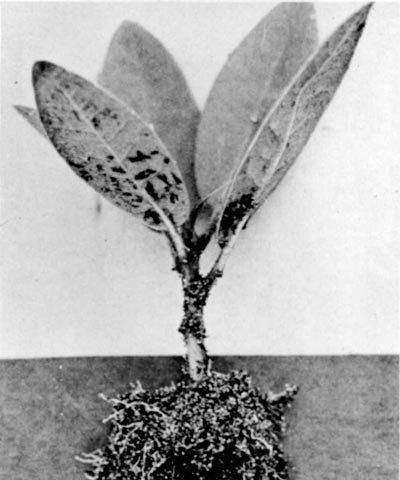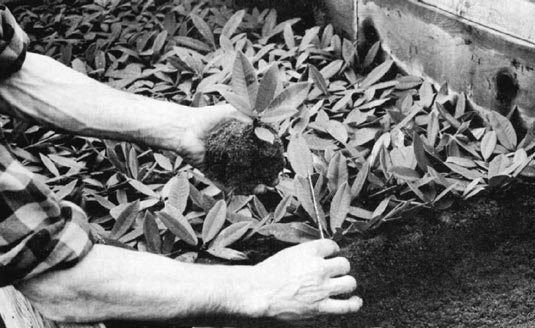QBARS - v5n2 The Propagation of Hybrid Rhododendrons from Cuttings
The Propagation of Hybrid Rhododendrons from Cuttings
P. H. Brydon
(Continued from the last issue)

|
|
Fig. 14: After eight weeks in the rooting medium the cuttings show the
first evidence of striking. Photo, Henny and Brydon, Inc. |

|
|
Fig. 15: R. 'May Day', showing a more advanced root system
a few weeks later. Photo, Henny and Brydon, Inc. |

|
|
Fig. 16: Rooted rhododendron cuttings being removed
from the benches in early spring. Photo, Henny and Brydon, Inc. |
Time Of Year To Take Cuttings:
From early July to late September is the period when rhododendron cuttings are usually taken, although there may be years when conditions warrant taking them as late as October. The best time would be during a cool spell of sufficient length so that there would be several days of cool weather prior to taking the cutting and also a like period following the insertion of the cutting into the rooting medium. Since cool spells of any length are infrequent during the months of July, August, and September, it is important that the propagator be on the alert for a period of favorable weather. Early morning is the best time of day, and if large quantities are to be taken, then a box containing wet moss ought to be used as a carrier to prevent the cuttings drying out.
Condition Of Stock Plants:
It is a practice among large commercial rhododendron growers to maintain a block of stock plants from which to take scions or cuttings. This is of questionable advantage. Our experience at Brooks has shown us that cuttings from young plants strike quicker and make much better plants than those taken from older specimens, especially where the stock plant has made short annual growths. I suppose that the ideal method to arrange the cutting block would be to plant enough of each variety so that the cuttings need only be taken from every other plant every other year. This would give the plants a change to regain their vigor between crops. The only objection to taking cuttings from young plants in a commercial nursery is that it cuts down on the saleable stock. In order that the cuttings be plump and fresh in the morning, it is wise to thoroughly water the stock plants in the evening prior to taking. The cleanliness of the propagating benches so far as insects and fungi are concerned, is predicated upon the cleanliness of the stock plants. Thrip, Lace Wing Fly, White Fly and various fungus diseases can ruin a batch of cuttings very easily if they are allowed into the benches on the cuttings. This is where a stock block of plants has the advantage over scattered specimens since it is quicker and easier to spray them in a group than to chase all over the place with the sprayer. A combination of Volck and Black Leaf "40" has proven to be very effective in the control of most injurious insects attacking rhododendrons.
Selection Of Wood:
We often read that "half ripe" wood is the best. This is a difficult term to define. I suppose that by this is meant wood of the current year's growth that has not yet reached maturity but yet is not soft and liable to wilt quickly when severed from the parent plant. The leaves should have attained full size and the growth in length of the stem should be practically at a standstill. Heavy growths are not particularly desirable, neither are whip-like shoots from inside the plant. In the 'Pink Pearl' class of hybrid, cuttings of pencil thickness are about optimum size. Thin shoots or short growths should be avoided whenever possible since no matter how much care they receive after rooting they rarely make robust plants. When removing cuttings from the plant, cut them back to the previous year's growth so that the resting buds in the axils of the leaves will be induced to break into growth. This may seem a waste of wood particularly in the case of strong growing types, but if there are stubs of the current year's wood left on the plant they produce very poor growth as well as being unsightly.
Preparation Of The Cutting:
As is shown in the accompanying illustration, the cuttings rarely exceed four inches in length. There does not seem to be any advantage gained by cutting them longer; in fact a stronger plant is obtained since there is less likelihood of the root ball breaking away from the stem when moving, than if a longer stem were left. Some growers recommend that a piece of the old growth be left on as a heel. From our experience, the presence of a portion of older wood on the base of the cutting seemed to retard rather than accelerate root formation. In most of the large-leaved hybrids, four or sometimes five leaves are allowed to remain; all others are removed by cutting the petiole close to the stem but leaving a small stub which will eventually dehisce of its own accord. The position of the basal cut on most cuttings of broad-leaved evergreens has been given considerable attention by many of the Experiment Stations. It is the consensus of opinion that a cut made in the area directly below the node gives the quickest response. From our observations I agree that this is also applicable in rhododendrons. With few exceptions, the leaves should remain uncut. I feel that since the cuttings are now solely dependent upon the leaves and stem for sustenance, then further reduction of the leaf surface would deprive the cutting of much needed food and essential elements. Some propagators have had good results by using proprietary root inducing substances now on the market although at Brooks we have never proved to our own satisfaction that the slight gain in time of rooting had much value. However, that is a moot point.
Insertion Of The Cutting:
The preparation of the medium has been discussed in an earlier paragraph where it was mentioned that the width of the cutting bench is approximately three feet. The cuttings are inserted 16 to a row with a space of 2 1/2" between the rows. We have found that, with the exception of small-leaved types such as 'Blue Tit', 'Carmen', 'Bric-a-Brac' etc., this measurement is about right and allows enough space for the removal of a good root ball with the cutting. This you can see in the illustration. The cuttings are pushed into the medium with he lower leaves touching the surface of the peat moss and sand. They are then firmed by laying a two-by-four parallel to the row and tapping smartly with a hammer. Immediately after the cuttings have been inserted, they are watered thoroughly and covered with the frames. These in turn are covered with several thicknesses of newspaper. Again I should like to stress that the cuttings be free of insect and fungus pests at time of insertion. If the stock plant has any indication of insect or fungi, these should be eliminated long before the cuttings are taken. Once the cuttings are off, simple dipping may kill the adult insects. However, this rarely kills the eggs which eventually hatch and give the propagators a bad time, for the balance of the year at least.
Light, Temperature, Moisture, Etc.:
Covering the frames with newspaper has a twofold purpose. It serves to maintain an even temperature within the frame and prevents the medium from drying out and reduces loss of atmospheric moisture from within the frame. It has seemed to me that, if the cuttings are kept relatively dark during the first ten days or two weeks, the formation of callus tissue is hastened. It has been demonstrated that roots do not arise from callus tissue. However, it is also known that the conditions which bring about the appearance of callus tissue aid in the formation of roots. Therefore, it seems that the practice of covering the frames with papers for the first two weeks is good. After the two week period has passed, the frames are opened once a week and any fallen leaves or dead cuttings are removed. The benches are given a thorough watering with a slow running hose to the point where the water runs out of the bottom of the bench. The temperatures during the rooting period will vary within the frame according to the heat of the day. The thermostats which control the heating cables are adjusted to a minimum of 60° F. al though the bottom heat rarely goes on during the summer and early fall months. To maintain an even moisture content within the benches, the paths and woodwork are dampened down frequently during the warmer weather. Before any cuttings are inserted, the exterior of the house is painted with a water soluble paint to reduce glare and keep temperatures at a minimum. A double thickness of cheesecloth tacked on the inside of the rafters is excellent although a little more expensive than an exterior application of water soluble paint.
Time Required To Root:
Within the hybrids there is a great latitude in the time between the insertion of the cutting and the point where roots begin to appear. The types such as 'Fabia', 'May Day', 'Vulcan', and other of the griersonianum clan will show roots within six to eight weeks, whereas others like 'Lady Bligh' and 'Harvest Moon' will just bide their time and begin to show roots in anywhere from 10 to 12 weeks. Some years, 'Pink Pearl' or 'Alice' will root almost one hundred percent and be out of the rooting medium and into the open bench in a matter of 4 months. In other years the percentage may be down to 50% and they may remain in the propagating bench until the beginning of February before they are large enough to take out. It is interesting to note that this same variance in rooting response of varieties will often occur in several growers nurseries during the same year. The illustration shows Mr. Wennekamp's strong right arm, with green thumb attached removing well rooted cuttings of 'Vulcan' from the rooting frame preparatory to planting them in the benches. This operation is generally carried out between the last of December and the beginning of February, at which time the cuttings have a solid root ball and, with the advent of a little warm spring weather, the young plants "takeoff" very quickly and are ready for the lath house beds by the middle of May.
